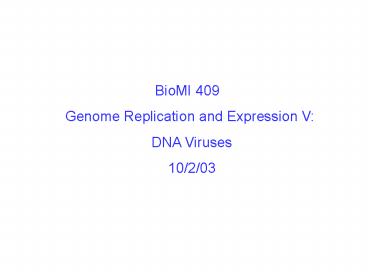Hepadnavirus DNA Genome - PowerPoint PPT Presentation
1 / 16
Title:
Hepadnavirus DNA Genome
Description:
DNA Virus Ori Recognition Proteins Share Common Properties ... Common Properties: ... Pold repairs gaps, ligase I joins fragments ... – PowerPoint PPT presentation
Number of Views:454
Avg rating:3.0/5.0
Title: Hepadnavirus DNA Genome
1
BioMI 409 Genome Replication and Expression V
DNA Viruses 10/2/03
2
SV40 Physical and Genetic Maps are Co-linear
(Based on Lai Nathans (1975) Virology 6670)
tsA, tsB, tsC temperature sensitive mutants
that genetically complement each other
3
Mapping the Replication Origin of SV40
isolate completely replicated SV40 genomes
4
Mapping the Replication Origin of SV40
(based on Danna Nathans (1972) PNAS 692391)
5
SV40 Ori
From Flint et al. Principles of Virology (2000),
ASM Press
6
SV40 T is a Multifunctional Protein with Discrete
Functional Domains
- Represses own transcription (negative feedback).
Opens up L promoter, - making it accessible to RNA pol II and
activating late gene expression
- Helicase Ori unwinding and movement of
replication fork. ATPase (energy)
- Binds host pRB and p53 to induces cells to enter
S phase and inhibit apoptosis
From Flint et al. Principles of Virology (2000),
ASM Press
7
DNA Virus Ori Recognition Proteins Share Common
Properties
All DNA viruses will encode at least one DNA
replication initiation protein
Larger viruses will also encode DNA polymerases
and other essential replication proteins
From Flint et al. Principles of Virology (2000),
ASM Press
8
Unwinding of the SV40 Ori
Two T hexamers bind pentanucleotide sites (II)
Flanking AT-rich element and early palindrome
(EP) protected, EP distorted
Host RpA (ssDNA binding protein) and T (helicase)
bidirectionally unwind DNA
From Flint et al. Principles of Virology (2000),
ASM Press
9
SV40 Strand Synthesis
DNA Pol a-primase binds RpA and T at Ori
RNA primers made, leading strand synthesis starts
RfC bind 3-OH of nascent RNA
Continuous, highly processive leading strand
synthesis
Lagging strand synthesis (3) initiates after
replication complex forms on leading strand
Topo I II remove supercoils to allow movement
of replication fork, Topo II breaks/seals to
separate strands
Rpreplication protein, Rfreplication factor
From Flint et al. Principles of Virology (2000),
ASM Press
10
Adenovirus Protein Priming of Linear dsDNA
Replication and Strand Displacement
4. Polpre-TP assembles and
5. Primes complementary strand synthesis
(continuous)
From Flint et al. Principles of Virology (2000),
ASM Press
11
Herpes Simplex Type I Genome Repeats and
Permutations
Long (L) and Short (S) regions can be inverted
relative to each other 4 forms
Each segment has Unique sequences (U) flanked by
internal and terminal repeats (IR, TR)
3 Oris 2 OriS, 1 OriL
Linear genome circularizes via direct repeats at
ends when enters cell
Permuted genomes result from recombination
between viral repeat sequences
From Flint et al. Principles of Virology (2000),
ASM Press
12
Model for Herpesvirus Replication Rolling
Circles
Rolling Circle Mode for FX174, l (late),
geminiviruses
2. Continuous synthesis displaces nicked strand
Recombination inverts 1 of 2 bidirectional forks
so move in same direction?
3 4. Multiple cycles of continuous synthesis
plus discontinuous synthesis on displaced strand
produce dsDNA concatemers
Cleaved in 1st terminal direct repeat (a) coupled
with encapsidation to generate linear genomes
From Flint et al. Principles of Virology (2000),
ASM Press
13
Common Features of Viral DNA Oris
Binding sites for Ori recognition proteins
Palindromes
AT-rich sequences Facilitate unwinding
Located within or near transcriptional control
regions
Binding sites for transcriptional activators and
enhancer binding proteins, viral as well as host
(increase replication efficiency)
From Flint et al. Principles of Virology (2000),
ASM Press
14
Further Reading
Flint et al. Principles of Virology (2000)
Chapter 8 Viral Proteins that Regulate
Transcription
Pages 253-281
Jog your memory about the cell cycle, how to
identify a promoter, and the modular structure of
sequence-specific transcription factors
(additional slides also on WEB site)
Chapter 11 Translational control
15
Sequence-specific Transcription Factors Have a
Modular Organization
- Bind to local regulatory regions of promoter
Increased flexibility in regulation
Can activate or repress transcription depending
on partner
From Flint et al. Principles of Virology (2000),
ASM Press
16
The Cell Cycle
Production, accumulation activities of cyclins
and Cdks are regulated
Wait for molecular signals cell regulatory
molecules are of 2 types
From Flint et al. Principles of Virology (2000),
ASM Press































